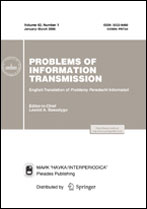|
|
Problemy Peredachi Informatsii, 2008, Volume 44, Issue 1, Pages 3–14
(Mi ppi1262)
|
|
|
 |
This article is cited in 38 scientific papers (total in 38 papers)
Coding Theory
Modeling Hexagonal Constellations with Eisenstein–Jacobi Graphs
C. Martineza, E. Stafforda, R. Beividea, È. M. Gabidulinb
a Universidad de Cantabria, Santander, Spain
b Moscow Institute of Physics and Technology
Abstract:
A set of signal points is called a hexagonal constellation if it is possible to define a metric so that each point has exactly six neighbors at distance 1 from it. As sets of signal points, quotient rings of the ring of Eisenstein–Jacobi integers are considered. For each quotient ring, the corresponding graph is defined. In turn, the distance between two points of a quotient ring is defined as the corresponding graph distance. Under certain restrictions, a quotient ring is a hexagonal constellation with respect to this metric. For the considered hexagonal constellations, some classes of perfect codes are known. Using graphs leads to a new way of constructing these codes based on solving a standard graph-theoretic problem of finding a perfect dominating set. Also, a relation between the proposed metric and the well-known Lee metric is considered.
Received: 18.10.2006
Revised: 01.11.2007
Citation:
C. Martinez, E. Stafford, R. Beivide, È. M. Gabidulin, “Modeling Hexagonal Constellations with Eisenstein–Jacobi Graphs”, Probl. Peredachi Inf., 44:1 (2008), 3–14; Problems Inform. Transmission, 44:1 (2008), 1–11
Linking options:
https://www.mathnet.ru/eng/ppi1262 https://www.mathnet.ru/eng/ppi/v44/i1/p3
|


|





 Contact us:
Contact us: Terms of Use
Terms of Use
 Registration to the website
Registration to the website Logotypes
Logotypes







 Citation in format
Citation in format 
